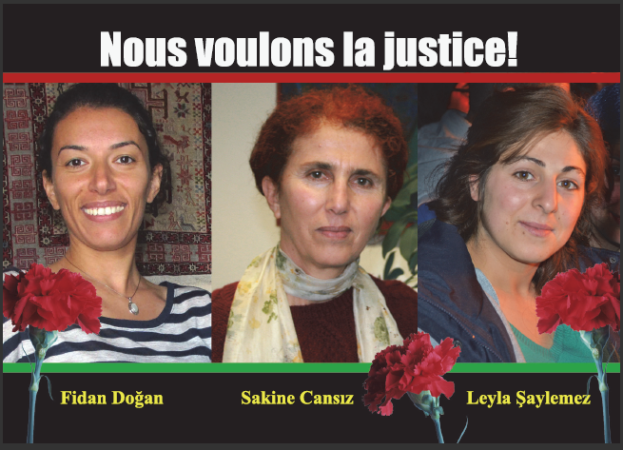Published by ANF on Saturday, December 17, 2016
It is reported that Ömer Güney, the sole suspect in the assassination of Sakine Cansız, Fidan Doğan and Leyla Şaylemez in French capital Paris on 9 January, 2013, has died.
French authorities have informed Cansız, Doğan and Şaylemez families about the death of Güney whose trial was set to resume in the coming months.
Ömer Güney was going to be put on trial in Paris Special Court of Serious Crimes. Güney was accused of murder in relation with a terrorist organization,
The families said they have learned about Güney’s death as they gathered today to assess the information submitted to their lawyers yesterday that Güney was severely ill and would demand to be released.
French authorities have made no official statement yet regarding the cause and time of Güney’s death.
Murat Şahin, a former member of the Turkish National Intelligence Organization (MIT) living in Switzerland, had said previously that Ömer Güney, the man under arrest since 19 January, 2013 in connection with the killings in Paris of Sakine Cansız, Fidan Doğan and Leyla Şaylemez, was a member of the MIT.
Turkish officials refused to cooperate with investigators and did not share the information MİT had on the massacre. The French government only publicized a few documents that had already been known by the public, and has been hiding the information it has on Ömer Güney. Investigators note that Güney was an MİT agent who infiltrated into the Kurdish movement for espionage and assassinations. French prosecutor Jeanne Duyé decided to close the case in May, 2015, two years after the massacre.
According to a last year’s report based on judicial sources close to the dossier, the investigators, without having been able to demonstrate, suspect MIT, the Turkish secret service, of involvement, as well as instigation and preparation of assassinations.
“Ömer Güney was proved to be involved in espionage activities, to have contacts with individuals in Turkey, and to have included the participation of a member of the MIT in his foiled plan of escape from prison during the investigation”, detailed the source.
A document on the massacre points at arrangements in Ankara, and this document helped further the investigation. On January 12, 2014, 3 days after the first year anniversary of the massacre, the shooter was heard in a voice recording leaked online as he spoke to two people from the Turkish intelligence on assassination plans. Two days after this recording’s dissemination, the written document instructing the shooter to assassinate Sakine Cansız became public. This document carried the signatures of MİT Branch manager O. Yüret, Department manager U. K. Ayık, Vice president S. Asal and President H. Özcan.
The document was originally issued on November 18, 2012, and emphasized that 6 thousand Euros were paid for the massacre.
Sakine Cansız, a co-founder of the PKK (Kurdistan Worker’s Party), KNK (Kurdistan National Congress) Paris Representative Fidan Doğan and Kurdish Youth Movement member Leyla Şaylemez were assassinated at the Kurdistan Information Centre in the heart of Paris on 9 January, 2013.
All the details and information revealed so far carry the traces of the murders to the Turkish capital Ankara.
An audio tape which contained the voice of Ömer Güney, who had infiltrated the Kurdish movement, talking to two Turkish intelligence operatives, was put on the internet on 12 January 2014, three days after the first anniversary of the murders.
The assassin, whose family had MIT (Turkish intelligence) links, discussed his activities in Paris, how he would eradicate his targets and the required money and weapons.
Two days later, a revealed document dated 18 November 2012 named various intelligence operatives and mentioned 6,000 Euros for ‘possible expenses’. In addition to Sakine Cansız KNK Executive Council member Adem Uzun was also mentioned in the document and attention was drawn to the fact that Sakine Cansız came to Paris a few days after Adem Uzun’s arrest on 6 October 2012 in a scandalous operation.
The joint conspiracy by French and Turkish intelligence against Uzun only emerged during the investigation into the murder of the three women, and he was released on 9 August 2013, with the French justice system accepting that ‘evidence had been illegally gathered’.
An investigation was also carried out by prosecutors in Ankara, but they refused to share information regarding the assassin with Paris.
Both French intelligence and Turkish intelligence refused to tell the French prosecutor what they know. In Turkey efforts were made to prevent the MIT being accused of involvement.
In April of 2015, the French government partially lifted restrictions on the publication of intelligence reports. 39 documents from the Internal Security organisation, DGSI, and 7 documents from the External Security organisation, DGSE, had been redacted.


